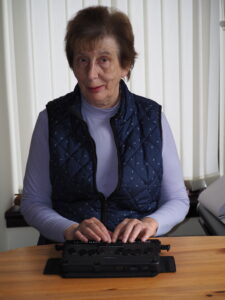“It shouldn’t be a luxury”: Marie Harrower on the Braille Food Labels Campaign
Marie Harrower is a member of the Oban and District Access Panel, a braille reader since childhood, and the driving energy behind the Food Labelling Campaign. In general terms, this campaign aims to make the food packaging manufactures put braille labels on their products. In a broader sense, it’s not just about the manufacturing process – it’s about inclusion that had to be implemented a long time ago yet was repeatedly postponed. Although it’s 2024, people with sight loss are still at great disadvantage while shopping in Scotland. Only a limited number of shops sell their produce with braille labels. It means that people are limited in their choices of grocery stores, should often seek assistance from staff, and even spend time and money on creating their own labels.
“Where labelling really comes into its own is when you arrive home with your shopping,” said Marie. “You’ve got three or four products all in very similar boxes and you think – which one’s which?”
She stressed that the importance of braille labels goes beyond the basic convenience of browsing shelves without asking for help to identify items.
“It’s not the shopping experience that would be a huge benefit. It’s the storing and retrieving that would be an enormous help.”
Despite braille being a recognised form of language, or “a blind person’s print” as Marie puts it, it’s downplayed by major grocery suppliers. Only a few of them use braille identifiers and, while a progressive gesture, it should be practised everywhere to include people with sight loss and prevent the monopoly on braille labels.
Currently, what should be a normal practice remains a “luxury” of modern times.
As for the wonders of technology and how they may be of help identifying products, it’s useful until it isn’t. One of them calls for the scanning equipment, which is yet another expense in a person’s budget. Obviously, experience operating it is also necessary. Then there are additional devices like smartphones to be connected to the scanner, and so on.
Marie described one of the popular labelling devices: “There is a piece of equipment called a ‘Penfriend Audio Labellers’: it allows you to digitally write the information on the label – like a scanning device. It requires you to record the information then stick the label onto the product.
“It is a good method of identifying products, but it does require some visual help to check if you have the label on the correct product. It’s perhaps not as practical for food because the changeover of food products is rapid.”
For more life examples, Marie’s detailed experience with braille language, and to understand why it isn’t not replaceable by technology, read the full interview by following the link:
www.accesspanel.scot/case-study-it-shouldnt-be-a-luxury-marie-harrower-on-the-braille-campaign/

